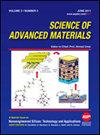Preparing High Strength and Elongation of Biodegradable Zinc–Magnesium Alloys with Superior Antibacterial Properties and Biocompatibility
IF 0.9
4区 材料科学
引用次数: 0
Abstract
The extrusion-formed Zn–0.5Mg alloy got a improved elongation and tensile strength by the addition of Mn. The influence of Mn on the strength contribution was investigated by comparing the microstructures of the designed Zn–0.5Mg and Zn–0.5Mg–0.2Mn alloys. The deformed binary Zn–Mg alloy had a grain size of 9 μ m, and the grain size of the deformed ternary Zn–Mg–Mn alloy was 3 m. This result indicated that the extrusion-formed Zn–Mg–Mn alloy had a greater contribution to grain boundary strengthening than the extrusion-formed Zn–Mg alloy. Furthermore, the precipitates in the two alloys show significant differences in size, morphology, density, and variety. Precipitates in the Mn-containing Zn alloy showed a smaller size, higher density, and the ratio of length and diameter. The high elongation rate of the extrusion-formed Zn–Mg–Mn alloy was attributed to the fully fragmented Mg 2 Zn 11 and deformable MnZn 13 phases. In addition to enhancing its mechanical characteristics, the Zn–Mg–Mn alloy, as extruded, exhibits the same corrosion rates, antibacterial properties, and biocompatibility. These results are helpful in expanding the applications of Zn alloys in the orthopaedic field.制备高强高伸长率具有良好抗菌性能和生物相容性的生物可降解锌镁合金
Mn的加入提高了挤压成形Zn-0.5Mg合金的伸长率和抗拉强度。通过对比设计的Zn-0.5Mg和Zn-0.5Mg - 0.2Mn合金的显微组织,研究了Mn对强度贡献的影响。变形后的二元Zn-Mg合金晶粒尺寸为9 μ m,三元Zn-Mg - mn合金晶粒尺寸为3 m。结果表明,挤压成形的Zn-Mg - mn合金对晶界强化的贡献大于挤压成形的Zn-Mg合金。此外,两种合金中的析出物在尺寸、形态、密度和种类上都有显著差异。mn - Zn合金中析出相尺寸更小,密度更高,长径比更大。挤压成形Zn - Mg - mn合金的高伸长率主要归因于mg2zn11的完全破碎和mnzn13的变形。除了增强其机械特性外,挤压后的Zn-Mg-Mn合金还具有相同的腐蚀速率、抗菌性能和生物相容性。这些结果有助于拓展锌合金在骨科领域的应用。
本文章由计算机程序翻译,如有差异,请以英文原文为准。
求助全文
约1分钟内获得全文
求助全文
来源期刊

Science of Advanced Materials
NANOSCIENCE & NANOTECHNOLOGY-MATERIALS SCIENCE, MULTIDISCIPLINARY
自引率
11.10%
发文量
98
审稿时长
4.4 months
 求助内容:
求助内容: 应助结果提醒方式:
应助结果提醒方式:


